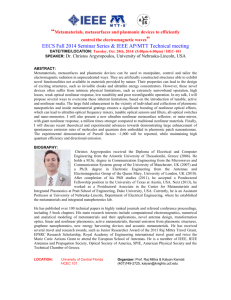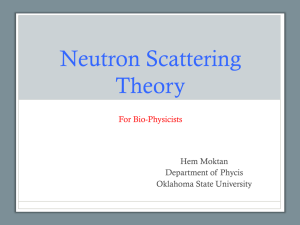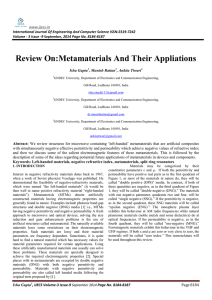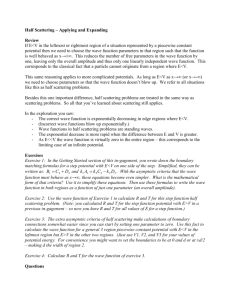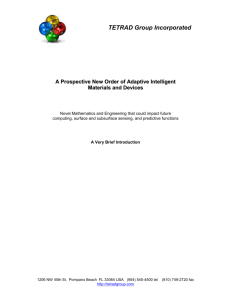ishimaru - University of Washington
advertisement
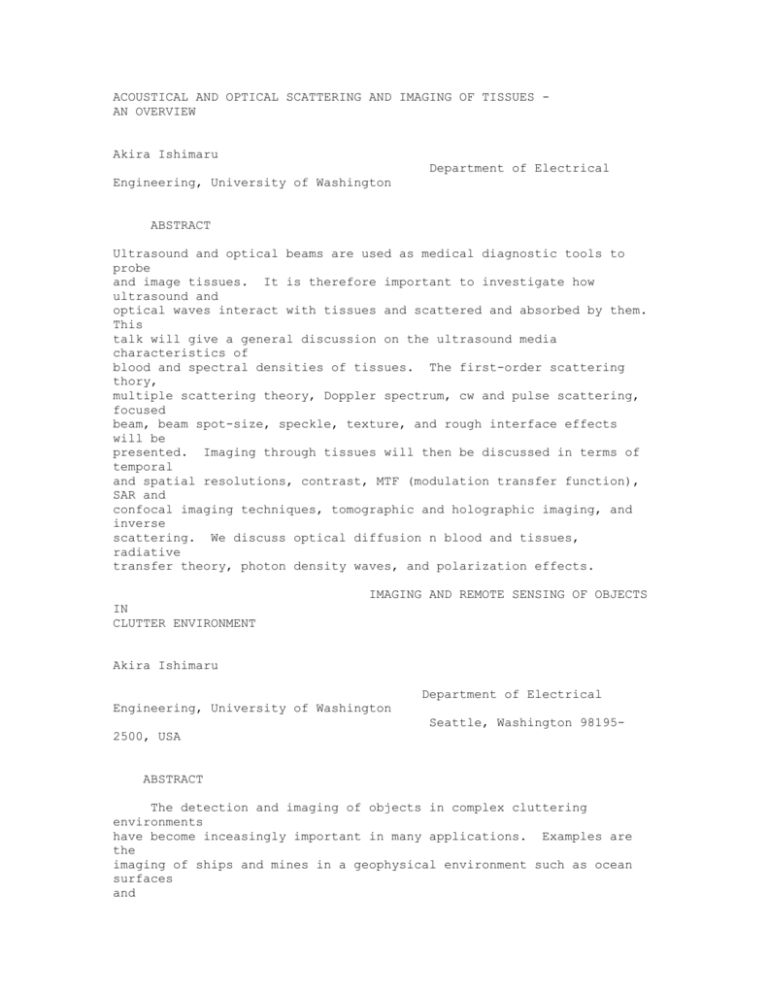
ACOUSTICAL AND OPTICAL SCATTERING AND IMAGING OF TISSUES AN OVERVIEW Akira Ishimaru Department of Electrical Engineering, University of Washington ABSTRACT Ultrasound and optical beams are used as medical diagnostic tools to probe and image tissues. It is therefore important to investigate how ultrasound and optical waves interact with tissues and scattered and absorbed by them. This talk will give a general discussion on the ultrasound media characteristics of blood and spectral densities of tissues. The first-order scattering thory, multiple scattering theory, Doppler spectrum, cw and pulse scattering, focused beam, beam spot-size, speckle, texture, and rough interface effects will be presented. Imaging through tissues will then be discussed in terms of temporal and spatial resolutions, contrast, MTF (modulation transfer function), SAR and confocal imaging techniques, tomographic and holographic imaging, and inverse scattering. We discuss optical diffusion n blood and tissues, radiative transfer theory, photon density waves, and polarization effects. IMAGING AND REMOTE SENSING OF OBJECTS IN CLUTTER ENVIRONMENT Akira Ishimaru Department of Electrical Engineering, University of Washington Seattle, Washington 981952500, USA ABSTRACT The detection and imaging of objects in complex cluttering environments have become inceasingly important in many applications. Examples are the imaging of ships and mines in a geophysical environment such as ocean surfaces and terrain. This paper first addresses the fundamental formulation of scattering by deterministic objects in a multiple scattering medium and rough surfaces based on the use of stochastic Green's functions. As an example, we condider the RCS of an object in a random medium. This includes the shower curtain effect which is caused by the different coherence length. It also includes the backscattering enhancement caused by the correlation between the forward and backward wave propagation. Next, we consider (i) the rough surface scattering, (ii) the stochastic integral equations describing the interaction between the object and the rough surfaces, and (iii) the multiply-scattered wave from the object. Each of the above three problems are discussed with examples. There have been several imaging techniques, such as angular and frequency correlations, interferometry, and confocal and SAR imaging. We discuss several image improvement techniques. The cross-polarization subtraction technique makes use of the difference between the co- and crosspolarizations to reduce the diffuse component. Photon density wave imaging makes use of the reduced diffuse components at higher modulating frequencies to improve the resolution. Recent work on optical coherence tomography can be applied to the array coherence technique, including the shower curtain effect and backscattering enhancement. WAVE CHARACTERISTICS AND APPLICATIONS OF METAMATERIALS Akira Ishimaru, University of Washington, USA ABSTRACT At present, a large body of electromagnetic research is based on the permeability of one, except magnetic material. In 1968, Veselago published a paper discussing some peculiar electromagnetic characteristics in a medium with simultaneously negative values of permeability and permittivity. This did not attract much attention until the late 1999's when Pendry, Smith and others actually produced a composite material with negative permeability and permittivity. This material is now called NIM (negative index medium), NIR (negative index of refraction medium), LHM (left-handed medium), or DNG (double negative medium). This study spurred intensive research on matamaterials, which are artificial materials whose permeability and permittivity can range from negative to positive. The peculiar wave characteristics in this medium include negative refraction, phase and group velocities in opposite directions, Poynting vectors and wave number vectors pointing in opposite directions, large evanescent powers and a possibility of focusing spot size much smaller that a wavelength. NIM is often highly dispersive and lossy. However, the use of lefthanded transmission lines may point to metamaterials with less dispersion and low loss. This lecture covers three important questions regarding matamaterials. First, we discuss the general analysis of wave characteristics in metamaterials, including phase and group velocities, Poyning vectors, loss and dispersion, reflection and transmission, and space-time wave packets. Several interesting wave phenomena are discussed, including backward surface waves and backward lateral waves. Secondly, we discuss how to construct metamaterials and the relationships between the constitutive relations and the physical geometries of inclusions in metamaterials, including bulk metamaterials and transmission line approaches. Thirdly, we discuss possible new applications of metamaterials, including plasmon sensors and focusing structures. Research on metamaterials is actibvely being pursued today, and new discoveries and applications are anticipated which may spur intensive new electromagnetic research in the future. Akira & Yuko Ishimaru 2913 165 th PL NE Bellevue, WA 98008 ph; 425 885 0018 fax;425 881 1622 ishimarua@aol.com
